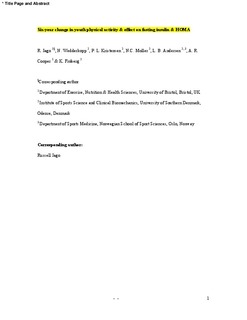| dc.contributor.author | Jago, Russell | |
| dc.contributor.author | Wedderkopp, Niels | |
| dc.contributor.author | Kristensen, Peter Lund | |
| dc.contributor.author | Møller, Niels C. | |
| dc.contributor.author | Andersen, Lars Bo | |
| dc.contributor.author | Cooper, Ashley R. | |
| dc.contributor.author | Froberg, Karsten | |
| dc.date.accessioned | 2009-05-04T11:24:27Z | |
| dc.date.issued | 2008-10-09 | |
| dc.identifier | Seksjon for idrettsmedisinske fag / Department of Sports Medicine | |
| dc.identifier.citation | American Journal of Preventive Medicine. 2008, 35(6), 554-560 | en |
| dc.identifier.issn | 0749-3797 | |
| dc.identifier.uri | http://hdl.handle.net/11250/170457 | |
| dc.description | I Brage finner du siste tekst-versjon av artikkelen, og den kan inneholde ubetydelige forskjeller fra forlagets pdf-versjon. Forlagets pdf-versjon finner du på www.sciencedirect.com: http://dx.doi.org/10.1016/j.amepre.2008.07.007 / In Brage you'll find the final text version of the article, and it may contain insignificant differences from the journal's pdf version. The original publication is available at www.sciencedirect.com: http://dx.doi.org/10.1016/j.amepre.2008.07.007 | en |
| dc.description.abstract | Background
There is a shortage of longitudinal data analyzing associations between physical activity and indicators of insulin resistance among children and adolescents after accounting for adiposity change. To guide future prevention efforts, data were used from the Danish arm of the European Youth Heart Study to examine these issues.
Methods
Participants were 384 students in Grade 9 (aged 15 years) from the municipality of Odense, Denmark, who participated in surveys in 1997 and 2003. Physical activity was monitored for at least 3 days by accelerometer, and mean counts per minute (CPM) and minutes >3000 CPM per day were obtained. Blood samples were collected, and levels of fasting insulin, fasting glucose, and homeostasis model of assessment of insulin resistance (HOMA-IR) were obtained. Data were analyzed in 2008.
Results
Physical activity declined from 45 minutes >3000 CPM in 1997 to 35 minutes >3000 CPM in 2003. Longitudinal regression analyses showed that a change in minutes >3000 CPM was negatively associated with fasting insulin levels (z=−2.47, p=0.014) and HOMA-IR (z=−2.31, p=0.021) in 2003. Similar findings were found when CPM was used as the physical activity variable. Results demonstrated that a 6-year decline in physical activity was associated with higher insulin and HOMA-IR levels.
Conclusions
The 6-year change in the volume of physical activity engaged in by adolescents aged 15 years was negatively associated with fasting insulin and HOMA-IR. Preventing an age-related decline in physical activity may be an effective means of preventing youth insulin resistance. | en |
| dc.format.extent | 285401 bytes | |
| dc.format.mimetype | application/pdf | |
| dc.language.iso | eng | en |
| dc.publisher | Elsevier | en |
| dc.subject | adolescent | en |
| dc.subject | analysis of variance | en |
| dc.subject | blood glucose | en |
| dc.subject | body composition | en |
| dc.subject | body mass index | en |
| dc.subject | child | en |
| dc.subject | cross-sectional studies | en |
| dc.subject | Denmark | en |
| dc.subject | female | en |
| dc.subject | homeostasis | en |
| dc.subject | humans | en |
| dc.subject | insulin | en |
| dc.subject | insulin resistance | en |
| dc.subject | logistic models | en |
| dc.subject | longitudinal studies | en |
| dc.subject | male | en |
| dc.subject | motor activity | en |
| dc.subject | obesity | en |
| dc.subject | physical fitness | en |
| dc.subject | risk factors | en |
| dc.title | Six-Year Change in Youth Physical Activity and Effect on Fasting Insulin and HOMA-IR | en |
| dc.type | Peer reviewed | en |
| dc.type | Journal article | en |
| dc.subject.nsi | VDP::Medical disciplines: 700 | en |
| dc.source.pagenumber | 554-560 | en |
| dc.source.volume | 35 | en |
| dc.source.journal | American Journal of Preventive Medicine | en |
| dc.source.issue | 6 | en |
